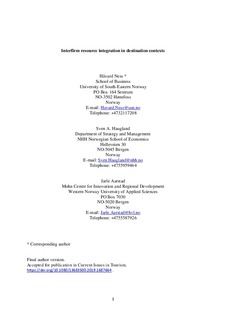| dc.contributor.author | Ness, Håvard | |
| dc.contributor.author | Haugland, Sven Arne | |
| dc.contributor.author | Aarstad, Jarle | |
| dc.date.accessioned | 2019-11-28T09:16:44Z | |
| dc.date.available | 2019-11-28T09:16:44Z | |
| dc.date.created | 2019-11-22T21:50:46Z | |
| dc.date.issued | 2019 | |
| dc.identifier.citation | Current Issues in Tourism. 2019, 1-17. | nb_NO |
| dc.identifier.issn | 1368-3500 | |
| dc.identifier.uri | http://hdl.handle.net/11250/2630845 | |
| dc.description.abstract | In a co-producing tourism destination context, interdependent firms providing the destination product need to coordinate their relationships to achieve resource integration. We focus on two key dimensions of esource integration: (1) interfirm resource complementarity and (2) adaptation of activity structures. Survey data from tourism firms at Norwegian mountain destinations show that both resource complementarity and adaptation of activity structures are a function of trust, authority-based governance, and interfirm learning. Trust and learning have overall stronger effects on resource integration than authority-based governance, in particular on the development of resource complementarity. Authority-based governance has a significant effect on the adaptation of activity structures and a borderline significant effect on resource complementarity. | nb_NO |
| dc.language.iso | eng | nb_NO |
| dc.title | Interfirm resource integration in destination contexts | nb_NO |
| dc.type | Journal article | nb_NO |
| dc.type | Peer reviewed | nb_NO |
| dc.description.version | acceptedVersion | nb_NO |
| dc.source.pagenumber | 17 | nb_NO |
| dc.source.journal | Current Issues in Tourism | nb_NO |
| dc.identifier.doi | 10.1080/13683500.2019.1687664 | |
| dc.identifier.cristin | 1751285 | |
| cristin.unitcode | 222,57,3,0 | |
| cristin.unitname | Institutt for økonomi, markedsføring og jus | |
| cristin.ispublished | true | |
| cristin.qualitycode | 1 | |
